Alcohol Withdrawal Delirium (AWD), is a severe life-threatening condition that typically arises when someone who has been drinking heavily for an extended period suddenly stops or drastically reduces their alcohol intake. It represents the most extreme form of alcohol withdrawal, characterized by acute changes in mental status and hyperactivity of the nervous system causing the body to have severe withdrawal symptoms. According to the National Library of Medicine, about 3-5% of individuals hospitalized for alcohol withdrawal symptoms experience AWD, showing its severity and the importance of medical oversight during detoxification.
The cause of Alcohol Withdrawal Delirium (AWD) is due to an individual stopping drinking abruptly creating an overactive central nervous system and triggering AWD symptoms. According to the National Institute on Alcohol Abuse and Alcoholism, this neurochemical imbalance is the primary driver of AWD in individuals with a history of heavy drinking.
Symptoms of AWD typically manifest between 48 to 96 hours after the last alcoholic intake but can occur up to 10 days later. These include severe confusion, agitation, fever, and trembling, along with hallucinations (visual, auditory, or tactile), high blood pressure, heavy sweating, and rapid heartbeat. Management usually requires hospitalization where treatments, primarily benzodiazepines, are administered to mitigate the symptoms and stabilize the patient’s condition.
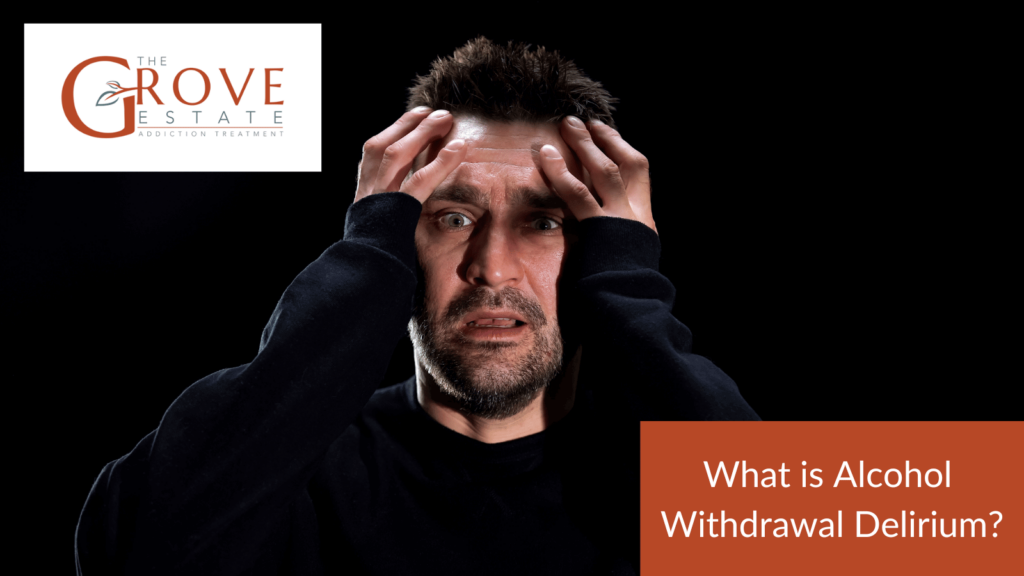
What is Alcohol Withdrawal Delirium?
Alcohol Withdrawal Delirium (AWD), also known as delirium tremens, is a severe condition that manifests during the withdrawal from prolonged and heavy alcohol consumption. It is marked by acute confusion, disorientation, vivid hallucinations, and severe agitation. Physical symptoms can include fever, rapid heartbeat, high blood pressure, and intense tremors. Typically, AWD begins 48 to 96 hours after the last alcohol intake but can have a delayed onset in some cases.
AWD is distinguished from regular alcohol withdrawal by its severity and potential for life-threatening complications. Regular withdrawal symptoms are less severe, ranging from mild anxiety and shakiness to moderate symptoms like sweating, nausea, and insomnia, usually starting within 6 to 24 hours after cessation of drinking. Unlike these more common symptoms, AWD requires immediate, intensive medical intervention in a controlled setting due to its serious nature. This distinction is critical for effective treatment and prevention of serious health issues.
What are the Symptoms of Alcohol Withdrawal Delirium?
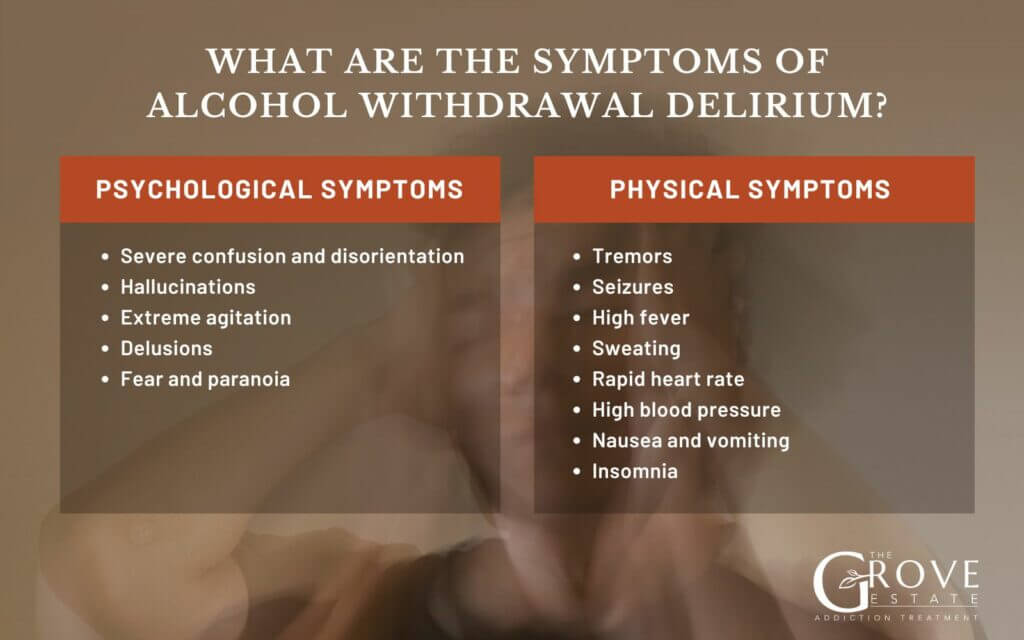
Alcohol Withdrawal Delirium (AWD), also known as delirium tremens, is the most severe form of alcohol withdrawal and presents with a range of intense psychological and physical symptoms. Here’s a comprehensive list of symptoms associated with AWD, including its distinct features:
Psychological Symptoms of Alcohol Withdrawal Delirium:
- Severe confusion and disorientation: Difficulty understanding what’s happening around them.
- Hallucinations: Visual, auditory, or tactile hallucinations, such as seeing or hearing things that aren’t there or feeling sensations on the skin with no apparent cause.
- Extreme agitation: Increased restlessness or aggressive behavior.
- Delusions: Strongly held false beliefs not influenced by logical reasoning or explained by a person’s usual cultural concepts.
- Fear and paranoia: Irrational feelings of being threatened or persecuted.
Physical Symptoms of Alcohol Withdrawal Delirium:
- Tremors: Shaking, often seen in the hands.
- Seizures: Can occur in severe cases and are more common in the first 12-48 hours after the last drink.
- High fever: Elevated body temperature not caused by an infectious agent.
- Sweating: Profuse, even in cool conditions.
- Rapid heart rate: Also known as tachycardia, which can be accompanied by palpitations.
- High blood pressure: Often fluctuating, can be dangerously high.
- Nausea and vomiting: Which can lead to dehydration if not managed.
- Insomnia: Difficulty in falling or staying asleep despite intense fatigue.
Alcohol Withdrawal Delirium (AWD) is far more severe than standard alcohol withdrawal, requiring hospitalization due to its intense, potentially life-threatening symptoms. Unlike the milder symptoms of standard withdrawal that can be managed outpatient, AWD often necessitates intensive care due to risks of complications like respiratory arrest and cardiac arrhythmias.
Can Alcohol Withdrawal Cause Hallucinations?
Alcohol withdrawal does cause hallucinations. Hallucinations during alcohol withdrawal primarily occur due to the brain’s attempt to readjust to the absence of alcohol after prolonged exposure.
Types of Hallucinations Experienced:
During alcohol withdrawal, individuals may experience various types of hallucinations, including:
- Visual hallucinations: Seeing images, people, or patterns that are not actually present. These are the most common types during alcohol withdrawal.
- Auditory hallucinations: Hearing sounds, voices, or noises that have no real source.
- Tactile hallucinations: Feeling sensations on the skin as if something is crawling on or touching the body, when there is nothing there.
The hallucinations experienced during alcohol withdrawal can be distressing and frightening, significantly impacting an individual’s mental and emotional state. They can lead to confusion, agitation, and fear, and in severe cases, may contribute to dangerous behavior if the person tries to react to or interact with the hallucinations.
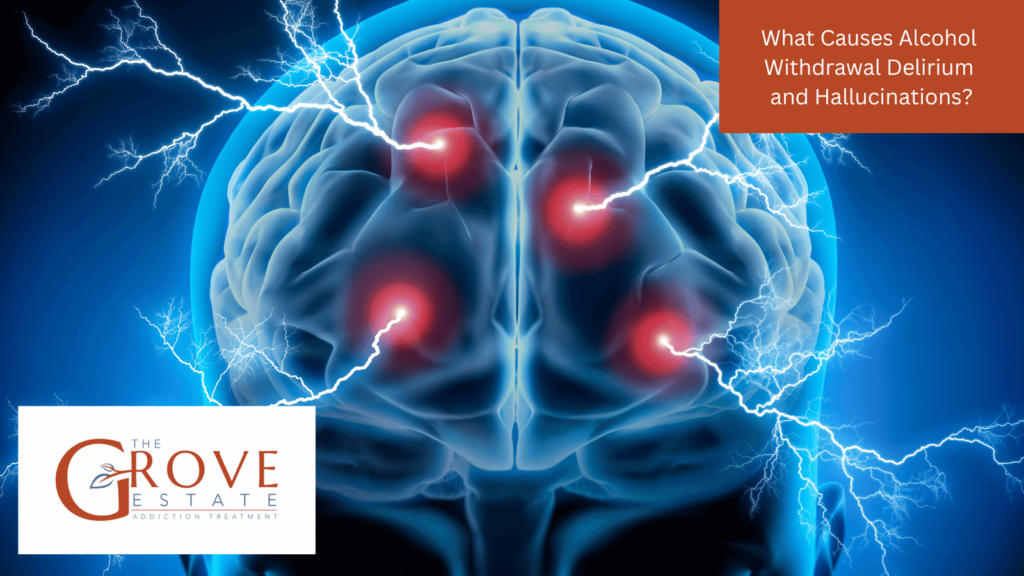
What Causes Alcohol Withdrawal Delirium and Hallucinations?
Alcohol Withdrawal Delirium (AWD) and hallucinations during alcohol withdrawal are primarily caused by significant physiological changes in the brain after prolonged alcohol exposure. Alcohol acts as a central nervous system depressant, modifying the brain’s neurotransmitters, notably gamma-aminobutyric acid (GABA) and glutamate. GABA reduces brain activity, while glutamate stimulates it.
Chronic alcohol consumption increases GABA activity and suppresses glutamate production, slowing brain functions. When alcohol intake is suddenly reduced or stopped, the brain experiences a rapid rebound in activity as glutamate production increases and GABA’s effects decrease, leading to overstimulation of the brain. This hyperactivity can result in symptoms of AWD, including severe confusion, agitation, and hallucinations.
What is the Alcohol Withdrawal Timeline?
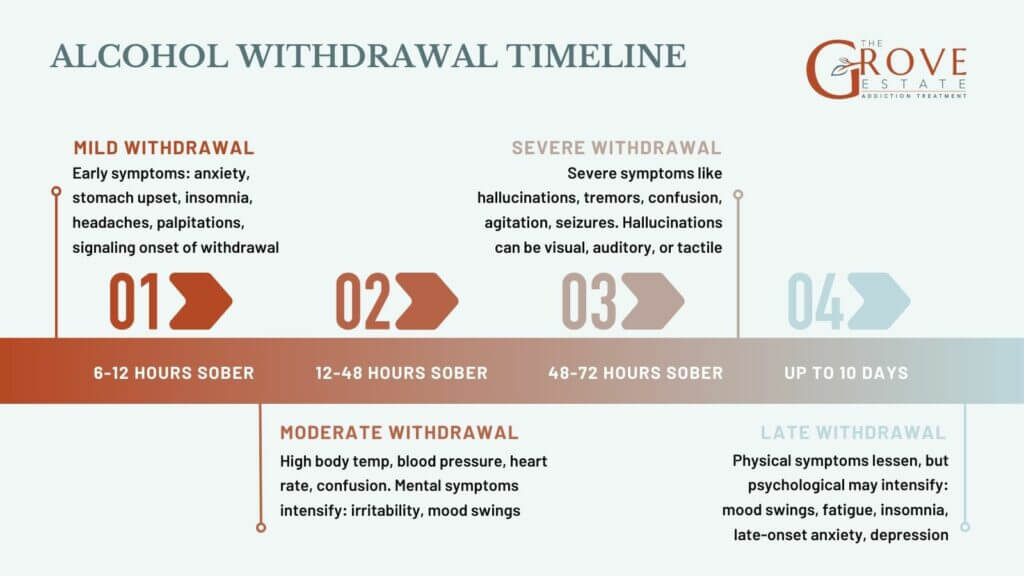
The alcohol withdrawal timeline varies by individual, depending on factors such as the duration and intensity of alcohol use, overall health, and personal physiology. Here’s a general breakdown of what to expect during the withdrawal process, including when hallucinations typically occur:
Stages of Alcohol Withdrawal
Stage 1: Mild Withdrawal (6 to 12 hours post last drink)
- Symptoms: This stage can include anxiety, stomach upset, insomnia, headaches, and palpitations. These symptoms are generally mild but signify the beginning of the withdrawal process.
Stage 2: Moderate Withdrawal (12 to 48 hours post last drink)
- Symptoms: Symptoms escalate to include increased body temperature, increased blood pressure, abnormal heart rate, and confusion. This stage can also include more pronounced mental symptoms such as irritability and mood swings.
Stage 3: Severe Withdrawal/Delirium Tremens (48 to 72 hours post last drink)
- Symptoms: This is the most critical stage, where severe symptoms such as hallucinations, severe tremors, profound confusion, and agitation occur. Hallucinations during this stage can be visual, auditory, or tactile. Seizures are also a risk during this stage, especially within the first 48 hours.
Stage 4: Late Withdrawal (up to 10 days)
- Symptoms: While most physical symptoms tend to decrease, psychological symptoms can linger or even intensify. This phase may involve continued mood disturbances, fatigue, and prolonged insomnia. Some individuals may experience late-onset withdrawal symptoms that can include persistent anxiety and depression.
How to Treat Alcohol Withdrawal Delirium and Hallucinations
Treating Alcohol Withdrawal Delirium (AWD) and hallucinations effectively requires a comprehensive approach, usually administered in a hospital setting. The cornerstone of treatment is the use of benzodiazepines, such as diazepam, lorazepam, and chlordiazepoxide, which are critical for reducing the severity of symptoms, managing anxiety, and preventing seizures. In cases where benzodiazepines are insufficient, antipsychotic medications like haloperidol may be used to control severe agitation and hallucinations. Additional medications like beta-blockers and alpha-2 agonists help manage cardiovascular symptoms by controlling blood pressure and heart rate.
Treatment also involves supportive care, which includes fluid replacement and nutritional support to address dehydration and malnourishment. Continuous monitoring is essential to manage and quickly respond to complications such as irregular heartbeats or potential seizures.
Once the acute phase is managed, long-term therapy and participation in support groups like Alcoholics Anonymous are recommended to help maintain sobriety and prevent relapse. Immediate and comprehensive medical intervention is crucial for safely managing the severe and potentially life-threatening symptoms of AWD.
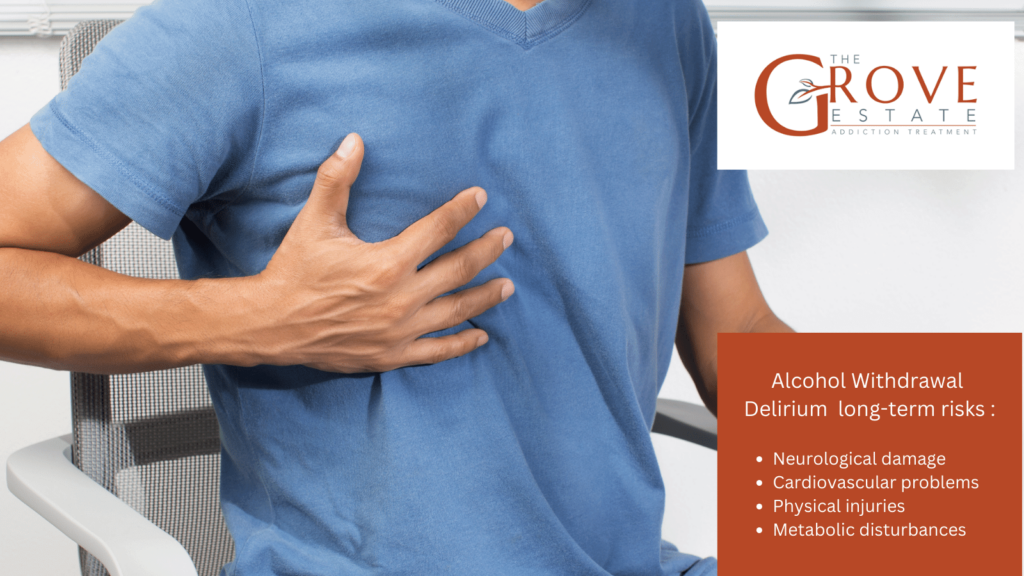
What are the Long-Term Risks of Alcohol Withdrawal Delirium?
Alcohol Withdrawal Delirium (AWD) poses significant long-term risks if not properly treated, leading to both immediate complications and chronic health issues. Untreated AWD can result in neurological damage from prolonged seizures, cardiovascular problems like irregular heart rhythms or heart attacks, injuries due to confusion and agitation, and serious metabolic disturbances due to electrolyte imbalances.
Over time, individuals who experience severe AWD may face cognitive decline, exacerbation of psychiatric conditions such as depression and anxiety, and social challenges like strained relationships and employment difficulties. Additionally, once someone experiences AWD, the likelihood of subsequent episodes increases, potentially escalating in severity. Therefore, effectively managing AWD is crucial, encompassing acute symptom control and comprehensive long-term care to prevent relapse and mitigate these risks.
How to Prevent Alcohol Withdrawal Delirium
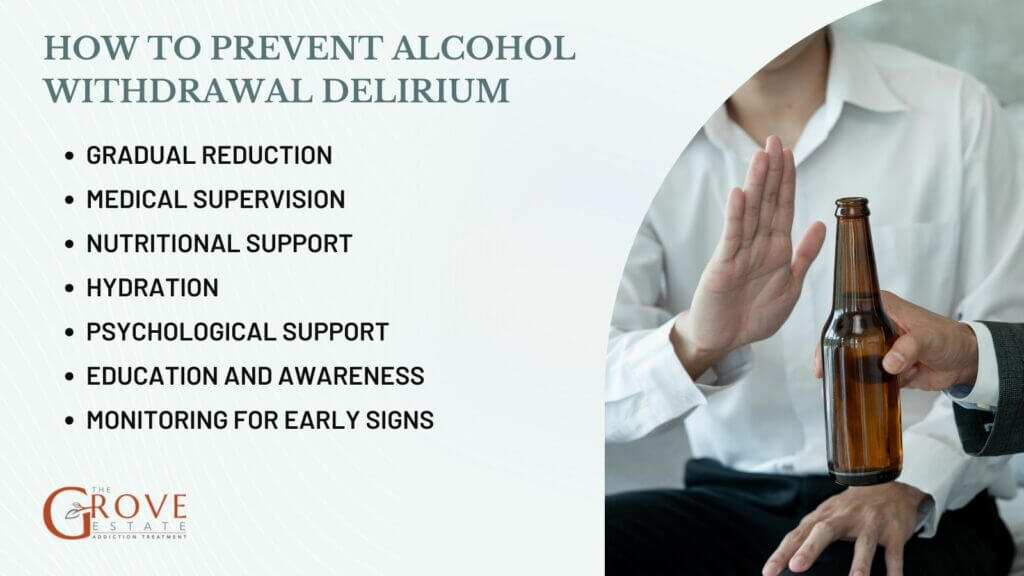
Preventing Alcohol Withdrawal Delirium (AWD) is essential because it’s a potentially life-threatening condition that can occur with sudden alcohol cessation. Following a strict procedure of steps will provide a comprehensive approach to prevent AWD, ensuring a safer withdrawal process. Here’s how to effectively prevent AWD:
- Gradual Reduction: Taper off alcohol gradually under medical guidance to reduce the risk of severe withdrawal symptoms.
- Medical Supervision: Engage with healthcare providers for monitored detox and appropriate medication use, such as benzodiazepines, to manage withdrawal symptoms.
- Nutritional Support: Address nutritional deficiencies with a balanced diet and supplements, essential for stabilizing body functions during detox.
- Hydration: Maintain adequate hydration to help manage symptoms and prevent complications during withdrawal.
- Psychological Support: Utilize therapy, counseling, or support groups to address emotional challenges associated with alcohol cessation.
- Education and Awareness: Learn about the risks of sudden alcohol cessation to recognize early withdrawal signs and act quickly.
- Monitoring for Early Signs: Watch for early symptoms of withdrawal to ensure prompt intervention and treatment.

Where Do I Find Support and Resources for Alcohol Withdrawal?
For individuals experiencing alcohol withdrawal, accessing professional medical assistance is crucial. Healthcare providers can offer safe management of withdrawal symptoms, including medical supervision and prescription medications. Additionally, support groups such as Alcoholics Anonymous provide peer support and a sense of community, which are invaluable during recovery. Local mental health clinics and online platforms also offer resources and counseling services that can help individuals navigate the challenges of withdrawal. Engaging with these resources can make a significant difference in managing the symptoms and ensuring a supportive path towards recovery.
Who is at risk for AWD?
Individuals at risk for Alcohol Withdrawal Delirium (AWD) typically include those with a prolonged history of heavy alcohol use. Those who have experienced withdrawal symptoms in previous attempts to reduce or quit drinking, especially if those symptoms were severe, are at higher risk. Additionally, individuals with underlying health conditions, particularly chronic diseases affected by alcohol use, are more susceptible to AWD.
Can AWD be prevented?
Preventing AWD involves gradually reducing alcohol intake rather than stopping abruptly, under medical supervision. This helps manage the withdrawal symptoms in a controlled manner.
Can you die from Alcohol Withdrawal Delirium?
Yes, AWD can be fatal without appropriate medical intervention. The risk of death is due to complications such as severe dehydration, cardiac issues, and respiratory failure.
What is the link between alcohol withdrawal delirium and seizures?
Alcohol withdrawal delirium (AWD) is known for its potential to cause seizures, which are a critical symptom that can occur during the withdrawal process. These seizures are typically generalized tonic-clonic seizures, which can be dangerous and require immediate medical attention. According to Healthline, the abrupt cessation of alcohol consumption can lead to a sudden decrease in gamma-aminobutyric acid (GABA) activity in the brain, which increases neuronal excitability and susceptibility to seizures.
The management of such seizures often necessitates the use of medications like benzodiazepines, which help stabilize brain activity and prevent further episodes. In addition, integrating medical approaches with therapies such as group counseling can provide comprehensive support, addressing both the physiological and psychological aspects of withdrawal, thus reducing the risk of complications and promoting a smoother recovery process.
Can dehydration exacerbate alcohol withdrawal delirium?
Dehydration is a significant factor that can exacerbate the symptoms of alcohol withdrawal delirium (AWD). Due to symptoms like sweating, fever, and vomiting, individuals undergoing AWD are at a high risk of dehydration, which can worsen confusion, increase heart rate, and intensify tremors. Healthline emphasizes the importance of addressing hydration as a priority during the treatment of AWD to help mitigate these severe symptoms.
Effective management of hydration and symptoms of AWD typically involves intravenous fluids to restore electrolyte balance and support overall physiological stability. This is often complemented by medical treatments, including alcohol poisoning care, where necessary, to ensure comprehensive monitoring and management of the patient’s condition during the critical phases of withdrawal.

Share This Post



